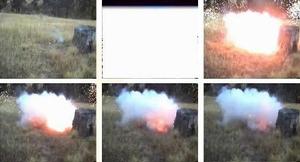Explosives detectionReal-time detection of PETN explosive with PTR-MS
PETN is an extremely powerful explosive, belonging to the nitroglycerine family, but is very stable; it is therefore a preferred explosive used by terrorists; a major problem for security personnel is that PETN is difficult to detect; academic, commercial organizations collaborate to develop PTR-MS technology for the detection of explosives — not only PETN, but also TNT, RDX, Semtex, and HMX

Detonation of 0.5 grams of PETN // Source: sciencemadness.com
The recent terror plot to transport printers containing the explosive pentaerythritol tetranitrate, or PETN, from Yemen to Chicago synagogues has once again focused attention on the need to detect explosives reliably and in real-time.
PETN is the same explosive that the shoe-bomber tried to set-off on an American Airlines jet to Miami in 2001. More recently PETN was involved in the failed attempt at setting off a bomb on an airliner in midair (Northwest Airlines Flight 253, 25 December 2009) by the Nigerian born Umar Farouk Abdulmutallab and in the attempted assassination of a member of the Saudi royal family this summer.
PETN is an extremely powerful explosive, belonging to the nitroglycerine family, but is very stable. It is therefore a preferred explosive used by terrorists. A major problem for security personnel is that PETN is difficult to detect. Analytical methods generally rely on the presence of residues left on the surfaces of freight containing explosives. A major difficulty associated with any analytical instrument, however, is to achieve high selectivity, thereby reducing false positives and negatives, whilst maintaining the high sensitivity required for trace detection.
In collaboration with researchers at the Universities of Innsbruck and New York and the University of Birmingham, Ionicon Analytik GmbH has been investigating the potential of the PTR-MS technology for the detection of explosives. Together, these organizations have demonstrated the capabilities of using PTR-MS for the detection of trace quantities of PETN (and other explosives (for example, TNT, RDX, Semtex, and HMX) on contaminated surfaces with extremely high selectivity (see Mayhew et al., Int. Journal of Mass Spectrometry 289 [2010] 58). Crucially, the identification of explosives, such as PETN, with a high level of confidence in real-time and in trace quantities is of great importance to the military, to emergency responders, and for applications in checkpoint security areas such as airports, harbors, and train stations.
